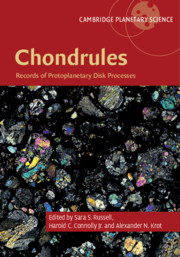Book contents
- Chondrules
- Cambridge Planetary Science
- Chondrules
- Copyright page
- Contents
- Contributors
- 1 Introduction
- Part I Observations of Chondrules
- 2 Multiple Mechanisms of Transient Heating Events in the Protoplanetary Disk
- 3 Thermal Histories of Chondrules
- 4 Composition of Chondrules and Matrix and Their Complementary Relationship in Chondrites
- 5 The Chondritic Assemblage
- 6 Vapor–Melt Exchange
- 7 Chondrules in Enstatite Chondrites
- 8 Oxygen Isotope Characteristics of Chondrules from Recent Studies by Secondary Ion Mass Spectrometry
- 9 26Al–26Mg Systematics of Chondrules
- 10 Tungsten Isotopes and the Origin of Chondrules and Chondrites
- 11 The Absolute Pb–Pb Isotope Ages of Chondrules
- 12 Records of Magnetic Fields in the Chondrule Formation Environment
- Part II Possible Chondrule-Forming Mechanisms
- Index
- Plate Section (PDF Only)
- References
8 - Oxygen Isotope Characteristics of Chondrules from Recent Studies by Secondary Ion Mass Spectrometry
from Part I - Observations of Chondrules
Published online by Cambridge University Press: 30 June 2018
- Chondrules
- Cambridge Planetary Science
- Chondrules
- Copyright page
- Contents
- Contributors
- 1 Introduction
- Part I Observations of Chondrules
- 2 Multiple Mechanisms of Transient Heating Events in the Protoplanetary Disk
- 3 Thermal Histories of Chondrules
- 4 Composition of Chondrules and Matrix and Their Complementary Relationship in Chondrites
- 5 The Chondritic Assemblage
- 6 Vapor–Melt Exchange
- 7 Chondrules in Enstatite Chondrites
- 8 Oxygen Isotope Characteristics of Chondrules from Recent Studies by Secondary Ion Mass Spectrometry
- 9 26Al–26Mg Systematics of Chondrules
- 10 Tungsten Isotopes and the Origin of Chondrules and Chondrites
- 11 The Absolute Pb–Pb Isotope Ages of Chondrules
- 12 Records of Magnetic Fields in the Chondrule Formation Environment
- Part II Possible Chondrule-Forming Mechanisms
- Index
- Plate Section (PDF Only)
- References
Summary
We review recent chondrule oxygen isotope studies by secondary ion mass spectrometry (SIMS). We discuss primary O-isotope fractionation characteristics of chondrule phases, and how they are used to garner information related to the physicochemical environment from which they formed. This includes high temperature gas–melt interactions, sampling of common precursors among different chondrite types, and how precursor compositions influenced redox states during chondrule formation. We also explore how primary O-isotope ratios of chondrule phases are disturbed by secondary alteration.
- Type
- Chapter
- Information
- ChondrulesRecords of Protoplanetary Disk Processes, pp. 196 - 246Publisher: Cambridge University PressPrint publication year: 2018
References
- 23
- Cited by

